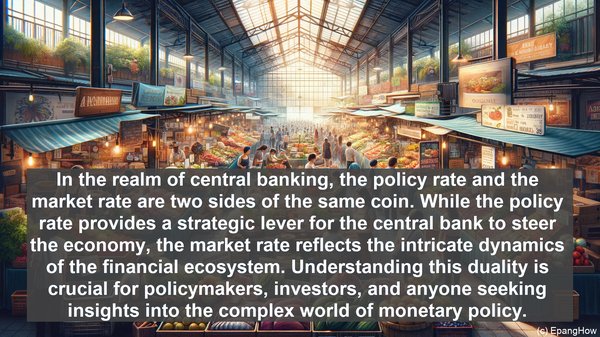Introduction: The Pillars of Central Banking
Greetings, fellow learners! Before we dive into the specifics, let’s establish a foundation. Central banks, the guardians of a nation’s monetary system, employ various tools to regulate economic activity. Among these tools, policy rates and market rates play pivotal roles. While both are interest rates, their purposes and implementations differ significantly.

Policy Rate: The Guiding Hand
At its core, the policy rate is the interest rate set by a central bank to influence borrowing costs within the economy. Often referred to as the ‘benchmark rate’ or the ‘base rate,’ it serves as a reference point for all other interest rates. By adjusting the policy rate, central banks can stimulate or restrain economic growth, depending on the prevailing circumstances.

Market Rate: The Dynamic Equilibrium
In contrast, the market rate, also known as the ‘real rate’ or the ‘effective rate,’ is determined by the supply and demand dynamics of the financial market. It is the rate at which borrowers and lenders agree to transact in the open market. Unlike the policy rate, which is set by the central bank, the market rate is influenced by a multitude of factors, including inflation expectations, credit risk, and market liquidity.
The Policy Rate’s Ripple Effect
When a central bank alters the policy rate, it sets in motion a series of reactions across the financial landscape. Commercial banks, for instance, adjust their lending rates based on the policy rate. This, in turn, affects the cost of borrowing for businesses and individuals. Consequently, changes in the policy rate can impact consumption, investment, and overall economic activity.
Market Rate: The Barometer of Risk and Return
While the policy rate provides a broad direction, the market rate reflects the market’s perception of risk and return. A robust economy, low inflation, and ample liquidity can lead to lower market rates, as lenders are more willing to extend credit. Conversely, during periods of uncertainty or tight financial conditions, market rates tend to rise, reflecting the increased risk associated with lending.
The Synchronization Challenge
In an ideal scenario, the policy rate and the market rate move in tandem, ensuring a smooth transmission of monetary policy. However, this synchronization is not always guaranteed. Factors such as market expectations, regulatory changes, or global economic conditions can create divergences between the two rates. Central banks closely monitor these divergences to assess the effectiveness of their policy actions.
